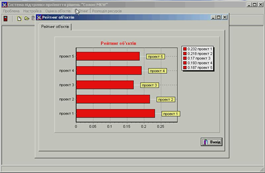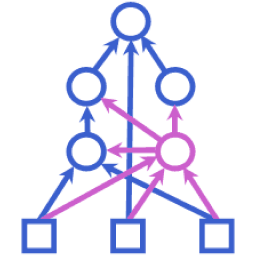Decision Support System "Solon-MC"
Decision support system “Solon–MC” is designed for decision-making support in situations where a certain part of alternatives (which are better than others according to the decision-maker and expert evaluation results) should be selected from a given set. Alternatives are estimated according to several qualitative and quantitative criteria.
Implementation of “Solon-MC” technology and DSS provides and opportunity for quantitative estimation of alternative preferences according to preferences implicitly expressed by the DM during pair comparisons of weights of criteria and respective scale labels. The technology is a universal one, since it does not depend on the nature of compared alternatives. It is also flexible, i.e. it allows the DM to use any alternative estimation criteria. Beside that, the system makes it possible to use the experience of many experts during both direct estimation of alternatives according to criteria and defining weights of criteria and respective scale labels.
“Solon-MC” DSS users are: establishments and enterprises of different property forms where the DSS can be used for selecting projects during tenders, appointing best candidates on vacant posts, equipment, software, contractor selection, etc.
Alternative selection in DSS “Solon–MC” is performed in several stages:
At the first stage the decision-maker (DM) selects criteria, according to which, in his\her opinion, alternatives must be estimated. At this point (s)he can select criteria from criteria set suggested by the system or formulate these criteria him(her)self.
The essence of the second stage is definition of criterion weights, conducted by the DM during a dialogue with the system. The system suggests the choice of the most suitable method for this from among several methods differing in accuracy (precision), labour intensiveness, question types, and information input modes. During this dialogue the DSS reveals contradictions in estimates of criteria preferences and helps the DM to eliminate these contradictions. At the same time the system calculates the quantitative consistency indicator of weight estimates provided by different experts, as well as sufficiency of consistency level. If this level is insufficient, the system suggests activities to be performed to achieve sufficient consistency of the estimates. When such level is achieved the system calculates aggregate quantitative values of consistent criterion weight estimates.
If the number of alternatives does not exceed 7-9 units, then at the next stage the experts input their estimates of relative significances (weights) of alternatives according to each criterion into the DSS. Once consistent alternative estimates according to all criteria are defined, the system calculates alternative ratings taking relative criterion weights into consideration.
Under larger (more than 7) number of alternatives, the next stage envisions calibration of scales for qualitative criteria, through pair comparison of criterion weight values. This process is similar to criterion weight definition.
After such system “fine-tuning” conducted in the specified way, experts are asked to estimate each alternative in accordance to the selected criteria set and input their estimates into the system.
At the next stage the system calculates the expert estimates’ consistency degree and defines if it is sufficient. In case of insufficient consistency of alternative estimates according to some criterion, the system suggests to re-estimate the alternative according to this criterion. After sufficient consistency level is achieved the system calculates consistent aggregate estimates of all alternatives according to each criterion taking criterion estimation scale weights into account.
The essence of the next stage is to calculate the alternative rating function values taking criterion weights and aggregate expert estimates of alternatives according to each criterion into account.
At the last stage the system ranks the alternatives according to their rating function values, and displays the results in a user-friendly way.

